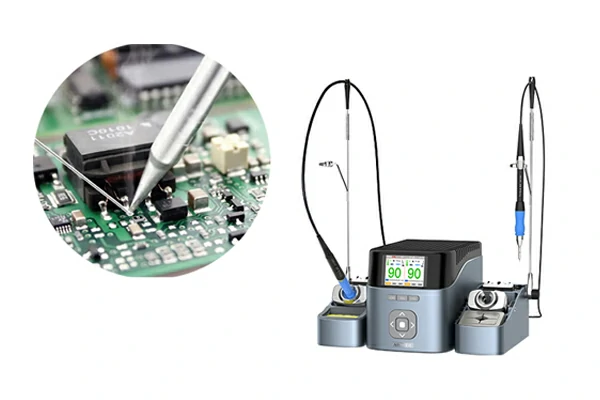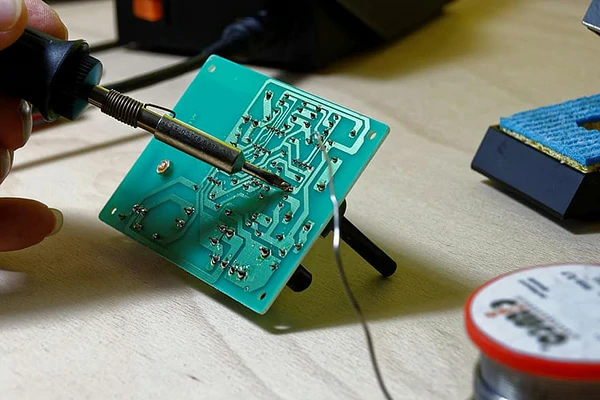
Soldering kit is a indispensable tool for any electronics enthusiast, DIY hobbyist, or professional looking to create, repair, or modify electronic circuits and components. This comprehensive guide will equip you with everything you need to know about soldering kits, from understanding their components to mastering essential techniques. Whether you're a beginner or seeking to refine your soldering skills, this article will be your ultimate resource.

Before diving into the specifics, let's explore the fundamental components that make up a standard soldering kit. These include:
Soldering Iron
The heart of any soldering kit, the soldering iron, is a heated tool used to melt solder and make electrical connections. Learn about the different types and wattages available to choose the one that best suits your needs.
Solder
Discover the various types of solder available, such as lead-based and lead-free options. Understand the composition and melting points to select the right solder for your projects.
Flux
An often-overlooked but crucial component, flux facilitates the soldering process by promoting the flow of solder and preventing oxidation. Learn why flux is essential for achieving clean and reliable connections.
Explore the benefits of a soldering station, which includes a temperature-controlled soldering iron and additional features for precision and safety. Understand how investing in a quality soldering station can enhance your soldering experience.

Safety is paramount in any soldering project. In this section, we'll cover:
Personal Protective Equipment (PPE)
Understand the importance of wearing safety gear, including safety glasses and heat-resistant gloves, to protect yourself from potential hazards.
Workspace Setup
Create a safe and organized workspace by implementing proper ventilation, using a heat-resistant surface, and organizing tools for easy access.
Electrical Safety
Learn about the precautions to take when working with electricity, including the importance of grounding and avoiding water exposure.
Selecting the appropriate solder is crucial for achieving reliable connections. This section will guide you through:
Types of Solder
Dive into the differences between lead-based and lead-free solder, considering factors such as environmental impact and application requirements.
Solder Diameter and Composition
Understand how the diameter and composition of solder impact the precision and strength of your soldered joints.
Now that you have a solid understanding of the basic components, let's walk through the step-by-step process of using your soldering kit:
Setting Up Your Soldering Station
Follow a detailed guide on how to set up your soldering station, including temperature control and tip selection.
Tinning the Soldering Iron
Learn the essential technique of tinning, which involves coating the soldering iron tip with a thin layer of solder for optimal heat transfer.
Soldering Techniques
Explore various soldering techniques, including through-hole soldering, surface mount soldering, and drag soldering. Understand when to use each technique for different types of components.
Enhance your soldering skills with expert tips and tricks:
Achieving Clean Joints
Discover techniques for creating clean and reliable solder joints, including proper solder application and avoiding common mistakes.
Heat Control
Master the art of controlling heat during soldering to prevent damage to sensitive components and ensure professional results.
Even seasoned soldering enthusiasts encounter challenges. In this section, we'll cover:
Cold Joints
Identify and remedy the issue of cold joints where solder fails to properly flow and create a reliable connection.
Solder Bridges
Learn how to avoid solder bridges, which occur when solder unintentionally connects two adjacent joints.
Component Damage
Discover ways to prevent damage to electronic components due to excessive heat or improper handling.
To get the most out of your soldering kit, proper maintenance is essential:
Cleaning Your Soldering Iron Tip
Understand the importance of regularly cleaning your soldering iron tip to ensure optimal heat transfer and prevent oxidation.
Storing Your Soldering Kit
Learn how to store your soldering kit properly to protect it from dust, moisture, and other environmental factors.
Ready to take your soldering skills to the next level? Explore advanced techniques such as:
Desoldering
Master the art of removing soldered components with precision using a desoldering pump or wick.
SMD Soldering
Delve into the world of surface mount device (SMD) soldering, which requires precision and specialized techniques.
Finally, let's explore some inspiring DIY projects that you can tackle with your newfound soldering skills:
LED Flashlight Assembly
Build your own LED flashlight from scratch, honing your soldering skills while creating a practical and customizable tool.
Electronic Gadgets
Explore the world of DIY electronic gadgets, from simple audio amplifiers to more complex digital displays.

With this comprehensive guide, you now have a solid understanding of soldering kits and the skills needed to handle various soldering tasks. Whether you're a beginner or looking to advance your soldering expertise, remember that practice and patience are key to mastering this invaluable skill. So, pick up your soldering iron, equip yourself with a reliable soldering kit, and embark on your journey to creating exciting electronic projects with confidence!
 WhatsApp
WhatsApp